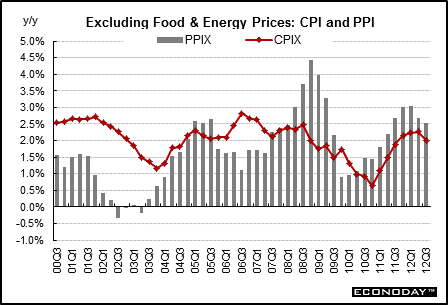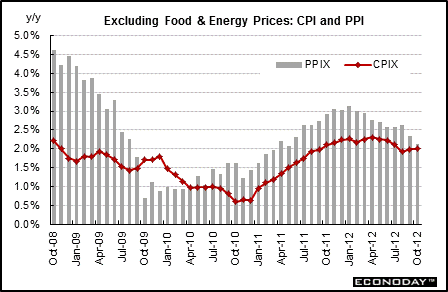 |

Usually, the CPI posts larger year-over-year gains because it consists of services, where prices are stickier and significant competition is sometimes lacking. The PPI consists of goods only, where competitive pressures are stronger and price changes are more flexible. Heavy demand for goods overseas pushed the core PPI up in the second half of 2007 and into early 2009. A slowing in the recovery eased both core rates during 2009 and early 2010. Weak housing, in particular, softened the core CPI through shelter costs. But in latter 2010 and early 2011, a strengthening economy boosted core PPI while the core CPI lagged. By mid-2011 and into 2012, an improvement in rent and motor vehicle components helped the core CPI to rise from a depressed pace. The core PPI does not have housing and other services to offset higher goods price inflation. The core PPI is more cyclically volatile than the core CPI.

Until recent entrenchment of the recovery, the core CPI had been on a downtrend for about four years, coming off a cycle peak of 2.9 percent in September 2006. In the first half of 2007, the core CPI had shown signs of moderating but turned back up late in the year due to strong world-wide demand and higher energy costs. By mid-2008, the core CPI had firmed and exceeded the top of the Fed’s comfort zone –1-1/2 to 2 percent yearly inflation for the PCE price index. The PCE price index tends to run about a quarter percentage point lower than the CPI. Continuing recession in the latter part of 2008 and early 2009 helped inflation to ease. From mid-2009 to mid-2010, the recovery was sluggish, keeping inflation down. A soft housing market has brought shelter cost inflation down significantly. But in early 2011, rates began to rise on healthier demand, a lower dollar, and higher oil prices boosting production costs. Also, some shelter costs began to firm. But a soft economy and stronger dollar led inflation pressures to soften in early 2012. The core CPI on a year-on-year basis in October stood at 2.0 percent, equaling the pace for the prior month. That for the core PPI eased to 2.1 percent from 2.3 percent in September.

 |


Production & Sales •
Inflation •
Federal Reserve Policy •
Interest Rates
|
 |